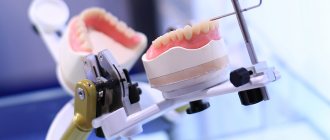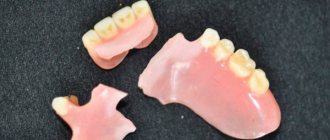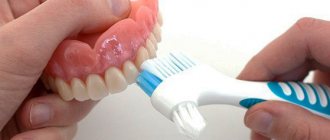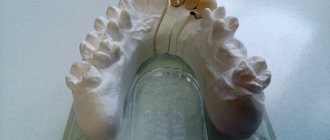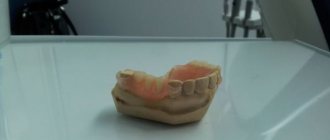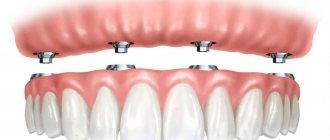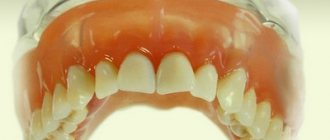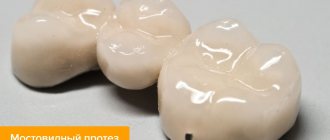- Complete removable dentures in Moscow
- Indications for use
- Types of removable dentures in complete absence of teeth
- Plate dentures for the entire jaw
- Removable dentures made of soft plastic
- Acrylic dentures for all teeth
- Removable nylon dentures
- Complete removable silicone dentures
- Clasp dentures for the entire jaw
- Pros and cons of complete dentures
- Preparation for prosthetics
- Manufacturing of complete removable dentures
- Fixation
- Care of complete dentures
- Complete removable dentures price
If we look at official statistics, almost half of the residents of our country by the age of 65 are faced with the problem of complete loss of teeth.
In medical practice, this phenomenon is called adentia. This situation should not be ignored, since edentia is not just an aesthetic defect that can cause psychological discomfort in the patient and affect self-esteem. Losing teeth is dangerous because it triggers a series of more serious health problems: the process of grinding food worsens, which leads to dysfunction of the digestive organs, impairs intestinal function, and as a result, the functioning of all internal organs is disrupted. The most progressive methods of restoring lost teeth are prosthetics on implants or the use of removable structures. Despite all the visible advantages of implantation, this method also has significant disadvantages. It may not be suitable for patients because it requires surgery, which may be contraindicated. And the second significant point is the high cost of all manipulations. An alternative, universal and suitable method of prosthetics for completely edentulous patients is the production and installation of removable orthopedic dental structures.
Removable dentures are distinguished by the fact that they can be removed and put on independently, at any time, without the involvement of specialists. There are two types of these structures:
- partially removable dentures;
- complete removable dentures.
Indications for use
As a rule, complete removable dentures are indicated for defects in a number of teeth, such as complete loss of chewing teeth. In addition, the pathological condition of the periodontium may be an indication. Severe periodontitis requires the installation of such structures; this will be the best solution for patients with this disease. The choice of the type of prosthesis depends on the specific case; the decision is made by the doctor together with the patient, based on a thorough examination of the oral cavity.
Implants
Strong fixation occurs due to the fact that they are installed as artificial analogues of living roots. Removable structures can be attached to implants and can be removed at home.
The best and most popular of those offered are implants and telescopic crowns. But for each patient they are selected individually by a highly qualified orthopedic dentist.
Due to the fact that the oral cavity is constantly mobile, displacement or loss of the structure often occurs. Therefore, there are additional means of fixation.
Types of removable dentures in complete absence of teeth
If there are no teeth left, the choice of design is significantly limited. Modern medicine offers the installation of prostheses on implants - this is the most reliable and most aesthetic method, but it is not available to everyone due to its high cost and indications. In this case, plate dentures remain - they are suitable for people of any age, if there are no allergic manifestations to the material used to create them. In the absence of teeth, all structures are similar in structure, but can be made of different materials. Let's decide what the pros and cons of different options are.
Plate dentures
Plate dentures, as the name implies, are a plate of different sizes. It acts as the basis of the structure, its basis. Fixing elements and artificial teeth are attached to it. Previously, such dentures were made exclusively from hard materials, but today dental technicians have a wider choice. This allows you to select products individually for patients, based on their needs and financial capabilities. But here it is necessary to remember that the material affects not only the comfort of wearing a denture, but also its service life.
Soft plastic dentures
Thus, acrylic products are considered the most durable. But since they are not always comfortable to wear, the formula of the material has been refined and improved. Complete removable dentures made of soft plastic were born. They are a combination of acrylic with the addition of additional components (for example, diamond chips). Their service life is very impressive, but due to their more plastic structure, they do not injure the gums, do not rub, and provide a tight fit.
Acrylic dentures
This type of prosthesis is the most popular - it is characterized by low price, aesthetics and ease of use. It consists of a base that covers the alveolar process and the body of the jaw, and artificial teeth attached to it. Before installing such a prosthesis, as in other cases, the oral cavity is first prepared for prosthetics, loose teeth are removed and the mucous membrane is treated, and then an impression of the jaws is made. Based on the impression, a primary model is created in the laboratory, which is adjusted and corrected after fitting. Acrylic or plastic prosthesis has the following advantages:
- an affordable way to completely restore teeth;
- ease of use;
- durability (7-9 years with proper care);
- uniform distribution of chewing load;
- quick adaptation period;
- lightness of the material, comfort of use;
- aesthetics and the ability to create a prosthesis that perfectly matches the color of natural gums;
- possibility of repair and correction;
- quick installation.
However, in order to decide which prosthesis is best to choose, you should know not only the advantages, but also the disadvantages of each type of design. For acrylic dentures, this is the possibility of an allergic reaction to the material, trauma to soft tissues during use, bad breath (acrylic is a porous material, bacteria can multiply in it), partial loss of taste, increased gag reflex, temporary impairment of diction and frequent need for correction. Most of these negative effects go away as you get used to the prosthesis, but some you have to put up with. To complete the adaptation period as quickly as possible, do not remove the denture at night.
Nylon dentures
The products are made from pink nylon, which is elastic and durable. They are similar to plate acrylic dentures, but differ from them in some parameters. This design perfectly imitates the gum and part of the alveolar process, it holds well and is suitable for sports enthusiasts. Such dentures are not removed at night even after the end of the adjustment period. A nylon prosthesis has the following advantages:
- hypoallergenic;
- high aesthetics;
- reliable fixation;
- low porosity, and, as a result, the absence of bad breath even after long-term use;
- flexibility, elasticity, comfortable use;
- durability (about 5 years);
- rare percentage of breakdowns.
The disadvantages of this type include the need for care of the prosthesis with the help of special means, the inability to repair in case of breakage, possible bone atrophy and mucosal injuries with prolonged use, uneven distribution of the chewing load (the flexible frame prevents this), the need for frequent correction and relatively high price.
In case of complete absence of teeth, implants are used to better fix the structure, and a metal arch is often used, which enhances the strength of the base. Thus, nyl dentures resemble dentures with a metal base and become even more durable.
Silicone prostheses
They are similar to nylon, but very different from them. Silicone is translucent; artificial – most often plastic – teeth are attached to a base made of it. Silicone dentures, as a rule, are used as temporary ones, because large gaps form between the teeth over time, and the service life of the structure is no more than two years, and it is rarely used for complete dentures. Their advantages:
- natural appearance;
- no allergic reaction;
- lightness and compactness;
- good fixation;
- softness of the material.
With prolonged use of the structure, atrophy of the alveolar bone and subsidence of the gums are possible, which is its significant drawback. In addition, they provide poor distribution of the chewing load and are difficult to maintain.
Clasp dentures
Clasp-type structures are practically not used in cases of complete edentia, since for strong fixation it will be necessary to create supporting surfaces. This requires additional time and financial expenses.
Types of prostheses by material
Dentures are made from a variety of dental materials. All of them have advantages and disadvantages, indications and contraindications for use. The orthopedic dentist must take all this into account. Basic requirements for materials: strength, biocompatibility with human tissues, lack of toxicity, allergenicity, effects on taste and olfactory receptors. The following types of materials are distinguished:
- metal – used for the manufacture of crowns, inlays, bridges; These are mainly precious metals, their alloys and hypoallergenic types of steel; titanium, as well as a nickel-cobalt alloy, are suitable for the manufacture of clasp dentures;
- zirconium dioxide is the most durable material; it looks beautiful in appearance, so it is used to make crowns of any teeth; The disadvantages include its ability to erase the surface of natural antagonist teeth;
- ceramics (dental porcelain) is a very fragile material in its pure form, so today it is rarely used in its pure form for making crowns and only for the front teeth; Dental materials made from glass ceramics are in great demand; famous world brands: Empress Esthetic (Ivoclar Vivadent, Liechtenstein) - glass ceramics based on lithium disilicate - a hard but quite elastic material, dental prostheses made from which can last a lifetime;
- E-max (Ivoclar Vivadent, Liechtenstein) - glass ceramics based on lithium disilicate; used for the production of crowns, inlays, veneers, bridges of the highest quality - hard, durable and very aesthetic, completely consistent with natural teeth; the crowns are very thin, so the teeth underneath do not require significant grinding;
- Ceramage (SHOFU Dental, Germany) - microceramics based on zirconium silicate;
- acrylic - the advantages of this material include lightness, plasticity, and affordable price; cons – removable acrylic dentures can cause allergies and often break;
You should trust your dentist in choosing the material. He will select the material that is most suitable in terms of properties, quality and price for a particular patient.
Pros and cons of complete dentures
Such designs are very popular; they have many advantages, including:
- Strength and elasticity . Prostheses are comfortable to wear, suitable for patients of all ages and safe. They are made according to an individual impression.
- High aesthetics . It is possible to choose the shape and color of teeth and gums as close as possible to natural ones. All this is selected on an individual basis.
- Easy to care for . Such structures are easy to care for; sometimes you just need to rinse them in running water.
The disadvantages include the following features:
- relatively long adaptation period;
- insufficiently stable fastening;
- feeling of discomfort when laughing, coughing or eating;
- not very long service life;
- food restrictions;
- violation of speech functions;
- the need for preventive regular examinations by a doctor.
How a partial denture is attached to the jaw
There are 3 options for fastening removable structures: hooks (clasps), locks (attachments), telescopic crowns.
We propose to consider each of the options in more detail. Clasps. They are hooks made of metal or plastic that grip healthy teeth and fix the orthopedic structure in the mouth. The disadvantage of such fastening is poor fixation and unsatisfactory aesthetics. Despite the fact that the hooks are covered by the lip, they are visible to others when smiling and talking.
Attachments. More preferable from an aesthetic point of view. The special lock consists of 2 parts. One element is built into the base of the prosthesis, and the other is attached to the crown that covers your own tooth. This fastening option has a more reliable fixation and gives the product stability. In addition, the attachments distribute the chewing load more evenly, which slows down bone atrophy by almost 2 times.
Telescopic crowns. Presented by a system consisting of 2 crowns. The inner one follows the contours of the ground tooth. The outer one is connected to the base and restores the shape of the tooth. This allows the prosthesis to be securely fixed and prevents it from moving. The possibility of installing a telescopic structure in each specific case is determined by the doctor, since grinding of a large layer of hard tissue of the supporting tooth is required.
Preparation for prosthetics
An important role in the manufacture of high-quality, comfortable designs is played by preparing the patient for prosthetics. The doctor conducts a detailed examination of the oral cavity, identifies individual structural features of the maxillofacial apparatus, and determines the characteristic features of the jaws. At this stage, the material for creating the future structure, the optimal shape, size and color of artificial teeth are selected.
Individual spoons are used. The composition of the mass for impressions is also selected personally. Based on the casts, a model of the jaws is made.
The finished product is made from wax or plaster models. This is quite painstaking work and is carried out using special equipment. In this case, it is important to clearly maintain the distance between the teeth, the depth of their fixation, inclination and many other parameters.
When trying on dentures, the dentist identifies possible nuances that prevent a tight fit. All comments are sent to the laboratory, where a dental technician adjusts the design.
What is dental prosthetics?
This is a set of therapeutic measures aimed at restoring the appearance, aesthetics of a lost tooth or the entire dentition, chewing function and speech. Dental prosthetics is also necessary to preserve the remaining teeth in the dentition, to prevent deformation of the lower, upper jaws and temporomandibular joints. Correctly installed modern structures can completely replace lost teeth. You just need to choose a dental clinic with a good reputation.
Manufacturing of complete removable dentures
The manufacturing process of both acrylic and nylon removable dentures occurs in several stages: taking impressions of the gums, casting a plate, welding teeth to it, and fitting the dentures to the patient’s jaws.
Acrylic dentures are produced by injection molding, and nylon ones are produced by hot injection under pressure. The latter method requires expensive modern equipment and qualified specialists who can work with such equipment. This has an impact on cost, and therefore nylon dentures are much more expensive than acrylic ones.
Lifespan of removable partial dentures
Practice shows that the service life of removable plate structures is on average 3-5 years, after which the structure has to be changed. Bugel products have a longer lifespan - up to 5-7 years.
In general, the duration of wearing depends on several factors:
— the quality of the design and the professionalism of the specialist who carried out the installation;
— characteristics of the body and the condition of the oral cavity, the presence of gum diseases and deformation of the dentition;
— accuracy of compliance with doctor’s recommendations and proper home care.
Care and storage
Dentures must be periodically removed from the mouth and cleaned. It's great if you do this every time after eating, but if this is not possible, you can rinse them in the morning and evening. Full dentures can be left in your mouth overnight, but it is best to remove them to give your gums a rest. In this case, before putting it in a special box, you need to thoroughly clean the prosthesis - rinse with boiled water, treat with an antiseptic solution or brush. It is recommended to have it professionally cleaned twice a year.
There is an opinion that the prosthesis should be stored in water or in a special solution. This is not so - a similar method was suitable for rubber prostheses, but modern technologies have made it possible to move away from it. Now it is enough to wrap the prosthesis in a cotton cloth and put it in a special box, where it will be protected from the sun, mechanical damage, heat and chemical influences.
Possible complications after dental prosthetics
If you choose the right clinic with qualified specialists, the risk of complications is minimal. But complications are sometimes associated not with medical errors, but with the characteristics of the dental tissues and the general health of the patient. Therefore, it is impossible to completely exclude them. Main causes of complications:
- incorrect choice of prosthesis design and material for its manufacture;
- untreated infectious and inflammatory processes in the oral cavity;
- violation of the technology of individual stages of prosthetics;
- patient's failure to comply with oral hygiene;
- the patient has common diseases that reduce immunity - diabetes, etc.
Types of complications:
- Infectious and inflammatory processes of the gums and oral mucosa (gingivitis, periodontitis, stomatitis) due to rubbing of soft tissues by the prosthesis or compression of blood vessels and nerves; if the problem cannot be resolved with antibacterial therapy, the prosthesis is removed, the pathology is treated and prosthetics are re-placed.
- Secondary caries – develops in supporting teeth under crowns; Thorough daily oral hygiene and professional teeth cleaning twice a year will help.
- Allergy to dental material – severe swelling of the mucous membrane, headache; requires immediate removal of the prosthesis, treatment and subsequent re-prosthetics using a product made of a different material.
- Destruction of the prosthesis - chips, cracks, etc. - can occur when eating hard food, hitting the jaw area, etc.; a small chip can be eliminated using modern filling materials; but if the product is completely destroyed, it must be replaced.
- Crowns that are too high or low - the chewing process and the load on the jaw tissue are disrupted; replacement of the prosthesis is necessary.
- A denture has fallen out - you need to save the fallen product and urgently contact a dentist.
Moderate pain after prosthetics is normal. They are associated with the adaptation of tissues to new designs and pass over time. But if the pain increases and is accompanied by swelling and redness of the tissues, you need to consult a doctor.
Signs of denture rejection
Sometimes (very rarely) rejection of the implant root occurs - the titanium root (the basis of the prosthesis) for some reason does not take root in the patient’s tissues. This can happen either one or two days after implantation, or much later. More often, implants do not take root in smokers and in patients who do not maintain oral hygiene. Signs:
- the gums bleed for a long time (more than three days);
- body temperature rises, it may not be high, but it can rise to significant numbers;
- moderate pain, which normally appears after implantation, sharply intensifies and becomes acute;
- the gum and adjacent cheek swell;
- after some time, pus appears from the gums;
- there will be a feeling of weakness, weakness, headache;
- the titanium root and the prosthesis installed on it can become mobile and even fall out of the gums.
If such symptoms appear, you should immediately contact your dentist.
Cost of complete removable dentures
| Name | Price from |
| Consultation with an orthopedic doctor | 500 rub. |
| Cost of complete removable dentures for both jaws | 60,000 rub. |
The cost of services is determined individually for each patient, since the individual characteristics of the patient’s oral cavity play a key role in the manufacture of structures. Factors such as the anatomical structure of the maxillofacial apparatus, the chosen type of structure, the material of its manufacture and methods of fixation, the shape and color of artificial teeth are taken into account.
Denta Labor dental laboratory produces complete removable dentures of excellent quality. Our laboratory has created all the conditions to produce high-quality prostheses with a long service life. You can check prices for removable dentures by phone 8 (495) 162-08-25.
Promotion! When paying in advance the full cost of making the prosthesis, the cost is reduced by 2000.
Telescopic crowns
They are more expensive compared to others. The supporting teeth are ground down and a much smaller crown is placed on them. The entire structure is installed on them, which holds tightly thanks to perfectly fitted shapes.
The points described above describe how removable dentures are attached to the presence of supporting living teeth. But how is a denture attached if there are no teeth?
Fixing strips
A remedy such as fixing strips is more often used for various malocclusion pathologies.
In addition, strips are useful if it is difficult to get used to dentures. They are made from a special material that ensures good fixation of removable structures. Additionally, the strips also protect the gums from damage. This product is very easy to use. Usually, for good fixation, the strip is immersed in warm water for a few seconds. Then it is applied to the prosthesis and inserted into the mouth together with it.
Glue
Denture adhesive acts as a soft cushion to cushion movement between the jaw and the structure during chewing. It is used for fastening both removable and permanent dentures (fixing a crown, temporarily strengthening a tooth or a broken bridge).
Adhesives are usually water-based.
The disadvantage of this product is associated with the gradual dissolution of the components and loss of effectiveness of the composition.
Excess glue can irritate your gums. The most commonly used glue is from Protefix, Corega, and Fittident.
Are partial dentures repairable?
During use, individual parts of the prosthesis may break off. Under no circumstances should you attempt to repair it yourself; it is better to contact a specialist. If the situation can be corrected, it will only take a couple of days to fix it.
Every six months to a year, during a scheduled visit to the dentist, it is necessary to reline the plate and clasp structures, since the contour of the gums and the level of bone tissue change over time. The adjustment improves fit and load distribution, resulting in the product not chafing or breaking.
Advantages and disadvantages
Prosthetics with plate prostheses have a number of advantages and disadvantages, which may vary depending on the type of structure. Before agreeing to have dentures installed, find out all the strengths and weaknesses of your new teeth. In addition, your attending physician should tell you about the types of plate prostheses and help you choose the best option.
- fragility (under heavy loads, a fracture of the plate prosthesis often occurs);
- short service life (up to 5 years);
- certain discomfort when wearing and difficulty getting used to (this applies to a greater extent to outdated designs);
- no load on bone tissue (except for installation supported by implants).
- ease of manufacture;
- low price. Prosthetics with removable plate dentures are considered one of the most cost-effective options for dental restoration in orthopedics;
- restoration of chewing function of teeth;
- acceptable appearance.
Creams and gels
Fixing a denture with cream or gel, which to choose? Both of these remedies are identical in their effectiveness and method of use. The only difference between them is the greater fluidity of the gels with the ability to form a thinner layer. Creams have a denser consistency and contain an additive of aromatic oils.
Rules for the use of gels and creams for dentures
Typically, experts recommend using creams to fix dentures immediately after prosthetics because of their ease of dosing and use.
But the amount of gel is more difficult to correctly calculate. If you increase its amount, the gel will not harden and hold the prosthesis normally.
Creams are applied to the lower segment of the denture, which is then pressed firmly against the gums. The creams reliably fix the structure for 12-24 hours.
The cream is especially recommended for patients with excessive salivation.
The most common and high-quality fixation creams are Rocs, Lacalut, Protefix, President, Corega, etc.
To choose the right means of fixation, you need to know such subtleties
- It is better to choose gels and creams with neutral scents. Fragrances in them are contraindicated for people with allergies.
- Preference should be given to waterproof products due to their longer action and better tightness. Waterproof types of compositions better protect against the penetration of food under the prosthesis and the development of unpleasant odors or inflammation.
- It is better to avoid using products containing zinc due to its toxic effect on the body (nervous and skeletal systems).
- Products with a gel-like consistency are more economical due to the ability to form a thinner layer during fixation.
Repairing a plate denture for teeth
Constructions of this type are considered quite fragile, especially at the point where the soft supporting part is attached to the artificial teeth. Repairing removable plate dentures is not always possible, and the degree of its success depends on the nature of the damage. In case of minor chips or breakage of clasps and attachments, restoration of removable plate dentures is often carried out, but in case of serious damage, the design usually has to be completely changed. The main reasons for the breakdown of plate dentures usually lie in careless handling (which often leads to falls of the structure) and attempts to bite through hard objects with dentures (for example, nut shells).
